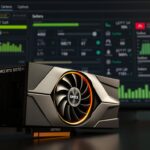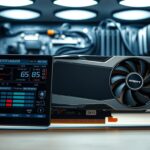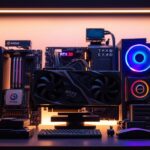Last Updated on August 16, 2025 by Gill
We’ve all been there. That moment when your favorite game stutters, and you wonder: “Could I squeeze just a little more power out of my setup?” For years, tweaking hardware settings felt like unlocking hidden potential—a secret handshake among PC enthusiasts. But today’s graphics cards aren’t the same as they were a decade ago.
Modern components come factory-tuned to near-maximum capacity. Pushing them further often means battling diminishing returns. You might gain a few extra frames, but at what cost? Heat buildup. Spiking electricity bills. The nagging worry that you’re shortening your hardware’s lifespan.
Manufacturers like NVIDIA and AMD now optimize their designs with precision. Cooling systems and power delivery are calibrated to balance speed with reliability. As one Reddit user put it: “Overclocking feels less like discovering treasure and more like rearranging deck chairs.”
This isn’t to say the practice is obsolete. Some gamers still find value in fine-tuning their rigs for specific titles. Others enjoy the challenge itself. But before you dive into voltage adjustments, ask yourself: Does the reward truly outweigh the risks for your gaming needs?
Let’s cut through the hype. We’ll break down how today’s engineering realities reshape this age-old debate—and help you decide if chasing those extra percentages aligns with your goals.
Understanding GPU Overclocking
Imagine your computer working faster than its default settings—like giving your car a nitro boost. That’s the essence of modifying hardware to run beyond factory specifications. While this concept applies to various components, today we’re focusing on graphics processing units.
What Is It?
At its core, this process involves adjusting your hardware’s internal timing. Think of it as recalibrating a metronome to tick faster. For visual processors, this means executing more calculations per second. A higher clock speed allows your system to render complex scenes quicker, which can smooth out gameplay or accelerate creative software.
How It Works
Two main elements drive these adjustments:
- Core frequency: Governs how fast the processor completes tasks
- Memory adjustments: Affects how quickly data moves between components
| Aspect | Factory Setting | Modified Setting | Impact |
|---|---|---|---|
| Core Clock | 1500 MHz | 1650 MHz | +10% task speed |
| Memory Speed | 14 Gbps | 15.5 Gbps | Faster texture loading |
| Voltage | 1.0V | 1.1V | Increased power draw |
Memory tweaks deserve special attention. When you accelerate VRAM operations, textures load faster, reducing pop-in effects during gameplay. However, pushing too hard can create instability—like trying to sprint a marathon.
GPU Performance Gain from Overclocking: Is It Worth It?
What if those extra frames per second could transform your gaming experience? A 10% performance boost might seem small, but it often bridges the gap between choppy gameplay and smooth visuals. For players stuck at 55 FPS in demanding titles, this tweak can mean hitting the coveted 60 FPS target without upgrading hardware.
Consider this scenario: Your favorite game runs at 43 FPS on ultra settings. Bumping that to 47 FPS reduces stutter during intense battles. While not earth-shattering, these gains matter most when you’re right below critical thresholds. Competitive shooters become more responsive, and open-world exploration feels fluid.
Three situations make adjustments worthwhile:
- Your system nearly hits desired frame rates but needs a final push
- You play older titles where extra headroom exists
- Budget constraints prevent immediate hardware upgrades
Modern tools let you test changes safely. Start with small core clock increases while monitoring temperatures. If stability holds, gradually adjust memory speeds. Remember: Results vary between games and hardware generations. A 15% improvement in one title might only yield 5% elsewhere.
Before diving in, ask yourself: Are occasional crashes acceptable? Is your cooling solution robust enough? For casual gamers, the answer might be no. But enthusiasts chasing every last frame often find the trade-offs justified.
Benefits of Overclocking Your GPU
Ever hit a frustrating lag spike right when victory was in sight? Tweaking your hardware settings might be the key to unlocking smoother gameplay and crisper visuals. Let’s explore how strategic adjustments can elevate your experience without breaking the bank.
Enhanced Frame Rates and Improved Game Performance
Higher clock speeds translate directly to better responsiveness. In fast-paced titles like Apex Legends or Call of Duty, even a 5-10% FPS boost can mean the difference between elimination and victory. Three key improvements emerge:
- Reduced input lag during critical moments
- Consistent frame pacing for fluid motion
- Fewer sudden drops in demanding scenes
These changes create a tangible advantage. Your crosshair moves precisely when you need it, and explosions render without stuttering.
Refined Visual Quality and Image Processing
Pushing your hardware lets you crank up shadow details and texture filtering. Games like Cyberpunk 2077 reveal hidden depth—neon signs glow sharper, rain-soaked streets reflect accurately. This happens because faster memory:
- Loads high-resolution assets quicker
- Maintains stable anisotropic filtering
- Reduces texture pop-in during exploration
While not a replacement for newer components, these tweaks help maximize what your current setup can deliver. For players wanting premium visuals without a $500 upgrade, it’s worth experimenting.
Drawbacks and Risks of Overclocking
Pushing hardware beyond its limits often reveals hidden costs. While modern components handle stress better than ever, chasing higher speeds still comes with trade-offs every enthusiast should consider.
The Hidden Costs of Speed
Extra power consumption hits first. Your system might draw 20-30% more electricity during peak loads. This not only raises energy bills but stresses power supplies. One Reddit user reported their rig tripping breakers after aggressive memory tweaks.
Heat becomes your constant companion. Faster clock speeds generate more thermal output—sometimes 10°C hotter than stock settings. While improved cooling helps, sustained high temperatures can warp circuit boards over time. Dust buildup accelerates this process.
Higher voltage requirements pose another challenge. Pushing components beyond factory specs demands precise adjustments. Too little causes crashes; too much risks permanent damage. Manufacturers now use durable materials, but physics still favors caution.
Modern cards handle these risks better than older models. Multi-phase power designs and vapor chambers help manage heat and power distribution. Yet even robust cooling can’t eliminate wear from constant overvolting. It’s like revving a car engine daily—eventually, parts fatigue.
Before making adjustments, weigh short-term gains against potential long-term costs. Sometimes, patience for next-gen hardware beats squeezing every last drop from current components.
Managing Power Consumption and Cooling Challenges
Heat becomes your frenemy when pushing hardware limits. While modern components handle thermal stress better than ever, smart adjustments keep your system running smoothly without sounding like a jet engine.
Optimizing Fan Speeds and Thermal Solutions
Balancing airflow and noise starts with custom fan curves. Most software lets you set RPM thresholds based on temperature. Try this approach:
- Keep fans at 40% speed until 60°C
- Gradually increase to 70% by 75°C
- Reserve maximum RPM for emergency cooling
Stock coolers often struggle with sustained loads. Aftermarket solutions like liquid cooling or triple-fan designs cut temperatures by 10-15°C. See how common options compare:
| Cooling Type | Noise Level | Temp Reduction | Cost |
|---|---|---|---|
| Stock Air | High | 0°C | $0 |
| Dual-Fan | Medium | 8°C | $50 |
| Liquid | Low | 14°C | $120 |
Power consumption spikes when overclocking. A 300W card might draw 340W under load. Use monitoring tools like HWInfo to track wattage and prevent circuit overloads.
Remember: Your environment matters. Systems in well-ventilated rooms with ambient temps below 25°C perform best. Clean dust filters monthly—clogged intakes force fans to work harder.
Fine Tuning Your GPU with Professional Tools
Customizing your graphics card settings doesn’t require a degree in rocket science anymore. Modern software turns complex adjustments into a streamlined process—think of it as having a digital pit crew for your hardware. The right toolkit lets you push boundaries while keeping risks in check.

Utilizing MSI Afterburner for Custom Profiles
This free software reigns supreme for fine tuning enthusiasts. Its intuitive interface lets you create game-specific configurations in minutes. Three standout features make it a pro favorite:
- Precision sliders for core clock and memory adjustments
- Real-time monitoring of temperatures and usage
- One-click profile switching between setups
Save separate profiles for esports titles and story-driven adventures. A CS:GO setup might prioritize maximum FPS, while Red Dead Redemption 2 could focus on stable 4K rendering. The software remembers your preferences automatically.
Strategies for Safe Overclocking Adjustments
Start small and test often—that’s the golden rule. Increase core speeds by 25 MHz increments, then run benchmarks for 15 minutes. If stable, repeat. Stop when artifacts appear or temperatures exceed 85°C.
Follow this battle-tested sequence:
- Boost core clock until instability occurs
- Adjust voltage slightly to compensate
- Increase memory speed in tandem
| Test Tool | Purpose | Duration |
|---|---|---|
| FurMark | Heat stress check | 30 mins |
| 3DMark | Performance validation | Full suite |
| Heaven Benchmark | Visual stability | 3 loops |
Advanced users can explore voltage-frequency curves for fine tuning efficiency. Pair these tweaks with custom fan curves to maintain thermal headroom. Remember: sustainable gains beat temporary spikes every time.
Real-World Insights from Reviews and Forums
The truth about squeezing extra power from modern hardware often hides in community forums and lab tests. TechPowerUp’s analysis of recent graphics cards reveals a pattern: most models only achieve 5-8% speed boosts before hitting thermal limits. One user joked, “My RTX 4070 gained fewer frames than my patience lost during testing.”
User Experiences and Community Feedback
Reddit threads tell mixed stories. Enthusiasts report spending hours tweaking settings for minor performance improvements—sometimes just 3-5 FPS in AAA titles. Common themes emerge:
- High-end models show less headroom than mid-range cards
- Power consumption spikes up to 30% for single-digit gains
- Stability issues outweigh benefits in productivity apps
A Discord poll found 62% of gamers abandoned overclocking after their first voltage-related crash. Others celebrate small victories, like hitting 144Hz in esports titles without upgrading.
Expert Opinions on Overclocking Reliability
Tom’s Hardware lab tests confirm what many suspect: factory settings leave little room for improvement. Their RX 7900 XTX trial achieved just 4.9% faster speeds before thermal throttling kicked in. Key takeaways from tech analysts:
- Modern architectures prioritize efficiency over manual tuning
- Memory overclocking often yields better results than core adjustments
- Diminishing returns accelerate with each hardware generation
GamersNexus put it bluntly: “The time investment rarely matches the outcome unless you’re chasing leaderboard spots.” For most users, occasional tweaks for specific games make more sense than permanent modifications.
Striking a Balance Between Performance and Longevity
When does pushing your hardware make sense versus upgrading? Modern graphics cards now ship with tighter limits but better safety nets. Manufacturers like ASUS and Gigabyte have refined production methods, making adjustments safer than ever—but not always smarter.

When to Tweak vs. Replace
Start by testing your current setup’s headroom. Run benchmarks before and after mild adjustments. If you gain 8-12% speed without hitting thermal walls, keep pushing. But if temps spike immediately, your card might already be at its peak.
Consider these factors:
- Budget: Spending $100 on cooling upgrades often beats buying a new $500 component
- Game requirements: Older titles benefit more from tweaks than cutting-edge AAA releases
- Time investment: Two hours of tuning equals 0.5% hourly wage for a $60k salary
| Scenario | Adjustments | Upgrade |
|---|---|---|
| 1080p gaming | +7% FPS boost | 30% costlier card |
| 4K rendering | Minimal gains | Required |
| Esports titles | Optimal | Overkill |
Mid-range cards from 2020-2022 often have untapped potential. Newer models? Less so. One Redditor noted: “My RTX 3060 gained 14 FPS in Fortnite—my friend’s 4070 only added 3.”
Ultimately, treat adjustments as temporary bridges. If you’re consistently hitting 90% GPU usage at stock settings, start saving for an upgrade. Your future self will thank you when next-gen titles arrive.
Conclusion
Deciding whether to push your hardware further isn’t just about raw numbers—it’s about matching your ambitions with reality. Today’s graphics cards arrive so finely tuned that manual tweaks often yield modest returns. While enthusiasts might enjoy the challenge, casual players should weigh the time investment against actual needs.
Modern manufacturing advancements have made adjustments safer than ever. Improved thermal designs and smart power management reduce risks that once plagued earlier generations. But chasing a 5% speed boost still demands careful cooling solutions and patience for trial-and-error testing.
Ask yourself these questions before diving in:
- Does your favorite title stutter below playable frame rates?
- Are you comfortable troubleshooting instability issues?
- Would upgrading components better serve your long-term goals?
For many, leaving settings at stock values proves the smarter way forward. Those needing every last frame for competitive gaming might find the effort justified. Either choice reflects personal priorities—there’s no universal right answer.
In the end, view tweaking as a temporary solution rather than a magic fix. As hardware evolves, so does the balance between customization and convenience. Your ideal setup ultimately depends on what you value most: maximum throughput or hassle-free reliability.
FAQ
Can pushing a graphics card beyond factory settings damage it?
How much faster can games run after overclocking?
Does overclocking void warranties?
Are stock cooling systems sufficient for stable overclocks?
Is MSI Afterburner the only tool for adjusting settings?
Why do some users avoid overclocking entirely?
Can overclocking improve non-gaming tasks?
- Optimize Your GeForce RTX 5070 Performance with Our Bottleneck Tool - October 2, 2025
- GeForce RTX 5090 Bottleneck Calculator: Optimize Your Setup - October 1, 2025
- GeForce RTX 5080 Bottleneck Calculator: Optimize Your Setup - September 30, 2025











